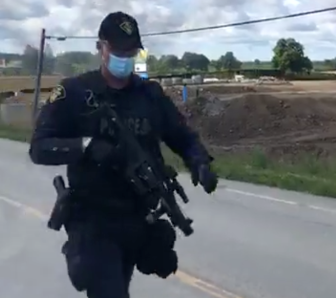Six Nations land defenders arrested by heavily armed police, at protest of Caledonia housing development
Written by: Brent Patterson
Photo by Real Peoples Media.
On July 19, Six Nations land defenders began occupying the site of a planned housing development site near Caledonia, Ontario. The 218-unit development is reportedly the first phase of a 1,000-unit development.
Land defender Skyler Williams says: “This is Six Nations territory and it’s going to remain Six Nations territory.”
By July 31, the Ontario Provincial Police (OPP) escorted a court sheriff who read and delivered an injunction against the occupation.
And on August 5, dozens of OPP officers raided the site and arrested 9 land defenders for not complying with the court injunction.
Williams has posted: “Several rubber bullet shots fired at land defenders.” Yotakahron Jonathan further confirmed on Twitter: “Rubber bullets fired by OPP at onkwehonwe (Original Peoples).” An unidentified woman in a video also commented: “Three paddy wagons of land defenders were taken from their traditional territory by force.”
The Chatham Daily News reports: “In retaliation, other members of the Six Nations of the Grand River shut down a nearby Highway 6 bypass, part of one street and another road, burning tires and barricading the roads. They also blocked a rail line running through Caledonia and turned back one train.”
A police helicopter was deployed as the protest expanded.
While the elected council of the Six Nations of the Grand River says it has “accommodated” the housing development (through the transfer of 42.3 acres of land and a $325,000 cash payment from the builders), many members of the community have not consented to this. The land defenders maintain that the housing development violates Haudenosaunee sovereignty and have named the site 1492 Land Back Lane.
Russ Diabo has explained some of the historical context: “[The Grand River tract] runs about a mile each side of the Grand River right down to Lake Erie. And they’ve lost over 90 per cent of it through improper, illegal sales to where they just have the existing Six Nations reserve today. …It’s the broader issue about the Grand River tract which is outstanding.”
The Hamilton Spectator further notes: “Williams said the Canadian government and band council alike need to consult more widely before further development can happen on disputed territory.”
Williams says: “If you’re not going to come to the table for meaningful discussion, to make it a real process where everybody in our community feels heard and accommodated and consulted with, then you’re going to continue to have these flashpoints in time where you’re met with resistance.”
A spokesperson for Losani Homes, one of the companies involved in the housing development, says this protest came as “a complete surprise”.
And yet one can look to the protests in Caledonia in 2006 against the Douglas Creek Estate development or this Toronto Star article from August 2017 that highlights the “disagreement between the elected band council and the Haudenosaunee Confederacy, a traditional government system comprised of five First Nations. The latter says it has been responsible for the lands for over 10 years.”
One can also look to the recent resistance to a 400-unit residential development on Kanehsatà:ke territory near Oka, Quebec.
The deeper complexities of the dispossession of Indigenous peoples from their lands, along with the repeated concerns articulated about the imposition of federal government sanctioned band councils versus traditional forms of Indigenous governance, speak to the need for a different approach rather than the familiar path of court injunctions, heavily-armed police enforcement and the arrest of land defenders.
More Articles
